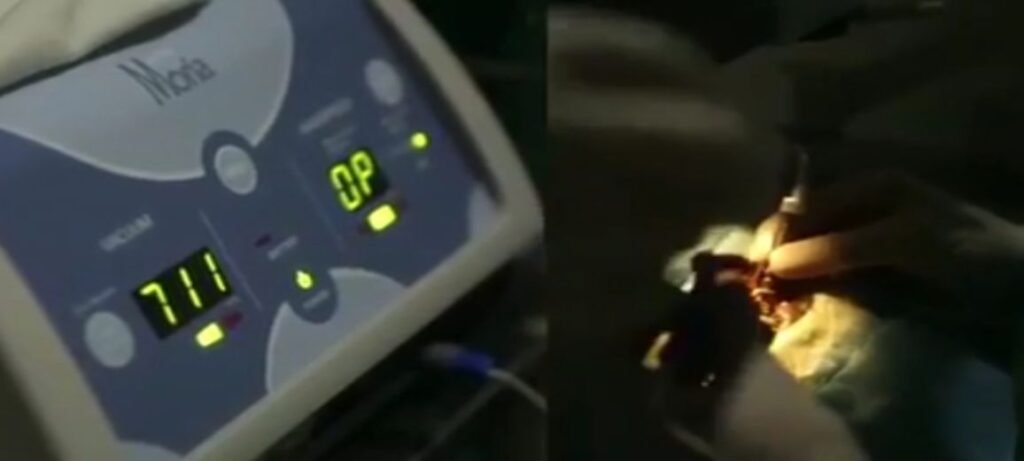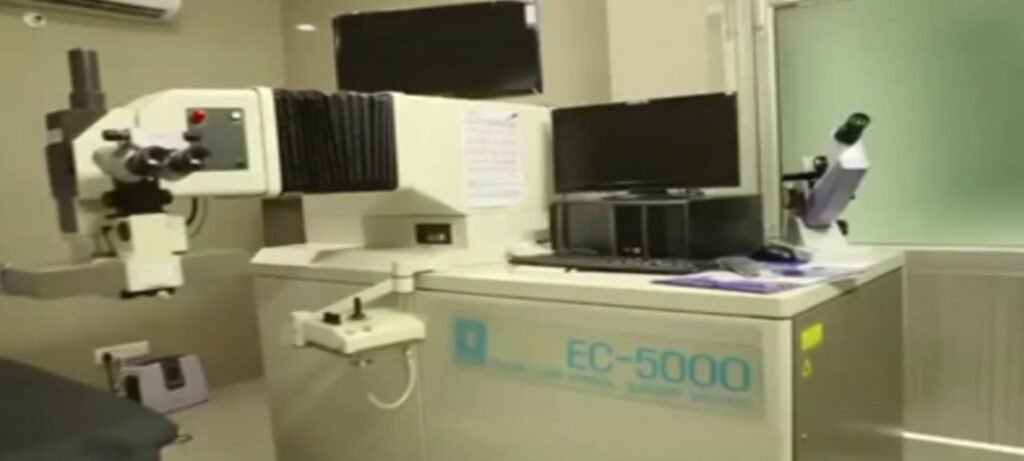Lasik & Refractive Surgery
Dhir Hospital in Bhiwani, Haryana, offers top-notch Lasik and refractive surgery by expert eye specialists.
- Home
- Service
- Lasik & Refractive Surgery
Overview
LASIK eye surgery is a common procedure to fix vision problems without relying on glasses or contact lenses. It uses a special laser to reshape the front part of the eye called the cornea. Usually, the cornea bends light accurately onto the back of the eye, but this bending is off in people with vision issues, causing blurry vision. LASIK corrects this by changing the cornea’s shape, improving vision, and eliminating the need for glasses or contacts.
When searching for the best LASIK treatment in Bhiwani, it’s essential to consider reputable eye clinics or centers that offer high-quality laser refractive surgery services. Look for experienced eye surgeons, positive patient reviews, and advanced LASIK technology. Additionally, check for certifications or accreditations demonstrating the clinic’s commitment to safety and excellence in providing LASIK treatment in Bhiwani.
Why is it done?
- LASIK surgery corrects vision problems like nearsightedness, farsightedness, and astigmatism.
- Nearsightedness occurs when the eyeball is too long, or the cornea is too sharply curved, causing distant vision to be blurry.
- Farsightedness happens when the eyeball is too short, or the cornea is too flat, resulting in blurry close-up and sometimes distant vision.
- Astigmatism is when the cornea is unevenly curved, affecting both near and distant vision.
- LASIK is an option if you wear glasses or contact lenses.
- Your eye doctor will discuss whether LASIK or a similar procedure is suitable for improving your vision.
Risk Factors
LASIK surgery is generally safe, but there are some common side effects and potential risks.
- Common side effects include temporary dry eyes and visual issues like glare, especially at night.
- Dry eyes might require eye drops or additional management from your eye doctor.
- Undercorrections may occur if too little tissue is removed, requiring another LASIK procedure.
- Overcorrections can happen if too much tissue is removed, and fixing them may be more challenging.
- Astigmatism, caused by uneven tissue removal, might need additional surgery, glasses, or contact lenses.
- Complications during the surgery, such as flap problems, can lead to infection or abnormal corneal tissue growth.
- Corneal ectasia is a serious complication where the cornea becomes too thin and weak, affecting vision.
- Regression is a less common issue where vision slowly reverts to the original prescription.
- Rarely, surgical complications may result in vision loss or changes in sharpness.
Conditions that Increase Risk
Certain health conditions may increase the risks or make the outcome less predictable for LASIK surgery. Doctors might not recommend LASIK if you have:
- Autoimmune disorders like rheumatoid arthritis.
- Weakened immune system due to medications or HIV.
- Constantly dry eyes.
- Recent vision changes include medications, hormones, pregnancy, breastfeeding, and age.
- Inflammation of the cornea, lid disorders, or eye diseases like uveitis, herpes simplex, glaucoma, or cataracts.
- Corneal disorders such as keratoconus or corneal ectasia.
How can you Prepare?
To prepare for LASIK surgery, consider these steps:
- Understand the costs: LASIK is typically not covered by insurance, so be ready to pay for it out-of-pocket.
- Arrange transportation: You’ll need someone to drive you to and from the surgery. After the procedure, you might still feel the effects of medication, and your vision could be blurry.
- Avoid eye makeup: Refrain from using eye makeup, creams, perfumes, or lotions the day before and the day of the surgery. Your doctor may also advise cleaning your eyelashes regularly before the surgery to reduce the risk of infection.
What can you expect?
Before the Procedure
- Stop wearing contact lenses: If you use contact lenses, you’ll need to switch to wearing only glasses for a few weeks before your evaluation and surgery. This is because contact lenses can affect the shape of your cornea.
- Evaluation process: Your eye doctor will review your medical and surgical history, conduct a thorough eye examination, and assess your overall health to determine if LASIK is safe.
- Checking for potential issues: Your eye doctor will look for signs of eye infection, inflammation, dry eyes, large pupils, and high eye pressure. They will also measure your cornea’s shape, thickness, and irregularities.
- Wave front-guided technology: This detailed test creates a map of your eye, helping the doctor precisely determine the amount of tissue to remove during LASIK surgery.
- Discussion about risks and benefits: Before the surgery, your doctor will explain the potential risks and benefits of LASIK, discuss what to expect before and after the procedure, and address any questions you may have.
During the Procedure
- Position: You lie down in a reclining chair.
- Relaxation: You might be given medicine to help you relax.
- Eye numbing: Numbing drops are placed in your eye.
- Eyelid opening: An instrument is used to hold your eyelids open.
- Suction ring: A ring is placed on your eye before cutting the corneal flap, causing a slight pressure and dimming of vision.
- Flap creation: Using a small blade or cutting laser, your surgeon creates a small hinged flap on the front of your eye.
- Cornea reshaping: A programmed laser removes tiny bits of corneal tissue to reshape it.
- Flap placement: The surgeon lays the flap back into place and usually heals without stitches.
- Focus on light: During the procedure, you focus on a light point to help the surgeon reshape your cornea. As the laser works, you might notice a distinct odor, similar to burning hair.
- Both eyes: If LASIK is needed for both eyes, it’s typically done on the same day.
After the Procedure
After LASIK surgery, you might experience temporary discomfort such as itching, grittiness, burning, and watery eyes. Initially, your vision may be blurry, but you should recover quickly with minor pain.
- Immediate recovery: You may be given pain medicine or eye drops for comfort. A protective shield over your eye at night might be recommended.
- Initial vision: You will be able to see, but clear vision may take time. While improvement is often seen within a few days, complete healing and stabilization of vision may take 2 to 3 months.
- Follow-up appointments: You’ll have a checkup 1 to 2 days after surgery and additional appointments as your doctor recommends in the first six months to monitor healing and address any complications.
- Resuming activities: It might take a few weeks before using cosmetics around your eyes or engage in strenuous activities like contact sports, swimming, or using hot tubs.
Results
- Success rate: More than 8 out of 10 people who undergo LASIK no longer need glasses or contacts for most activities.
- Vision improvement: Most achieve 20/40 vision or better, suitable for daily tasks.
- Factors affecting results: Success depends on your specific vision issues. Those with mild nearsightedness often have the best outcomes. People with high nearsightedness, farsightedness, or astigmatism may have less predictable results.
- Possible issues: Undercorrection is rare, and additional surgery may be needed for proper correction. Sometimes, vision might slowly return to pre-surgery levels due to various factors like wound healing problems, hormonal changes, pregnancy, or other eye conditions like cataracts.
- Regular check-ups: It’s crucial to have regular follow-up appointments with your doctor to monitor your vision and address any changes or concerns.
Our Related Services

UVEITIS
At Dhir Hospital , we are committed to providing our uveitis patients with advanced quality eye care at affordable prices.

Paediatric Ophthalmology
Dhir Hospital has the best pediatric ophthalmologists in Bhiwani, Haryana to treat ophthalmology disorders in children.

Ophthalmic Plastic and Facial Aesthetic Surgery
Searching for the best oculoplastic surgeon In Bhiwani, Haryana? Contact Dhir Hospital to get treated by the best eye specialists for eyelid surgery in Bhiwani, Haryana..

Binocular Vision and Orthoptic
Get the best eye hospital in India for Binocular vision and orthoptics treatment without any difficulty at Dhir hospitals in Bhiwani, Haryana.
FAQ
Frequently Ask Questions.
Lorem ipsum dolor sit amet, consectetur adipiscing elit.
To be eligible for LASIK surgery, there are a few criteria that need to be met:
- Stable Prescription: Your spectacle prescription should not have significantly changed within the past 12 months. This ensures that your refractive error has stabilized, allowing for accurate correction during LASIK surgery.
- Healthy Ocular Surface: It is important that you do not have any ocular surface abnormalities, such as dry eyes or other conditions that may affect the healing process post-surgery. A healthy ocular surface ensures better surgical outcomes and optimal visual results.
- Adequate Corneal Thickness: Your cornea, the clear front part of the eye, should have sufficient thickness for safe and effective LASIK surgery. This is important to ensure that enough corneal tissue can be safely reshaped during the procedure.
These criteria are essential for determining if LASIK surgery is suitable and safe for you. Our ophthalmologists will conduct a thorough evaluation of your eyes to assess these factors and provide personalized recommendations based on your individual circumstances.
After a routine eye examination, the ophthalmologist may recommend a vision corrective procedure for the patient. At Dhir Hospital located in Bhiwani, Haryana, advanced diagnostic equipment is used to gather information about the patient's eye structure and function, including corneal thickness, corneal curvature, and optical aberrations. The ophthalmologist carefully reviews the eye test reports and consults with the patient to make a final decision regarding the most suitable treatment option.
At Dhir Hospital, laser surgery is conducted on an outpatient basis, meaning that patients are able to return home immediately after the procedure. It is recommended to have a relative or friend accompany you to provide transportation after the surgery. Typically, one eye is treated at a time, and the procedure is performed under topical anesthesia.
During the procedure, you will be asked to lie down on a couch and focus your gaze on a blinking green light through a microscope. Your vision may temporarily fade out when the suction ring is applied, but it will return once the ring is removed. The entire procedure usually lasts only a few minutes, and most patients do not experience any pain during the process.










